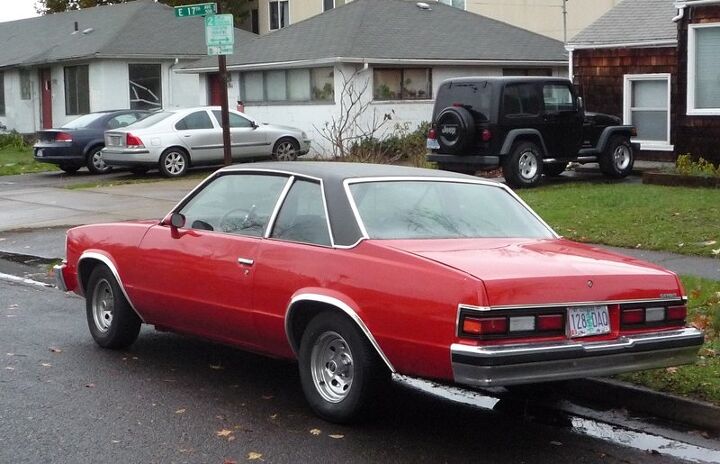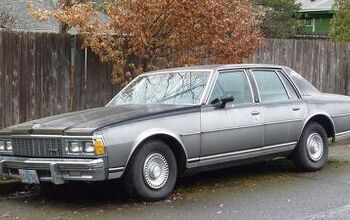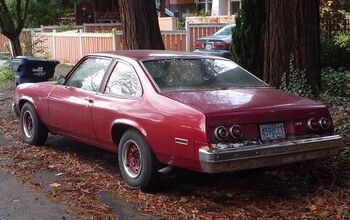Curbside Classic: 1979 Chevrolet Malibu Coupe

Walking around some blocks of the student neighborhood near the University of Oregon on a gray winter’s day can be as depressing as recalling much of GM’s decline and fall products from the seventies on. It’s a sea of dull and cheap apartments already looking shabby and run-down rental houses, fronted by waves of drab colored hand-me-down Toyotas, Nissans, and the like. But every so often, a cheery sight appears, like this cherry-red 1979 Malibu coupe. It’s there to remind me that GM was still able to hit a few high notes while cranking out Vegas, Monzas and Citations; and that it hadn’t yet totally forgotten the magic formula that it first hit upon in 1955 and reprised with the ’64 Chevelle: a trim and tidy RWD coupe weighing about 3,000 pounds and powered by the SBC V8. Quite the mood elevator indeed.
One of the key aspects of the story of GM (and the rest of Detroit) can be summed up by this: the lure of the “bigger is better” is followed to an extreme, and a crash diet follows. This has led to a sea of monstrosities as well as a few genuine moments of clarity and even a hint of brilliance, which this Malibu is a prime example of. It’s far from perfect, marred mainly by the indifferent quality of the components it’s composed of. But as a design, or even an ideal, it hits a note of near-perfection. Smack dab in a sea of bulbous and obscene landau-roofed “mid-sized” barges from Ford and Chrysler, GM dropped this clean, compact, elegant, handsome coupe in our midst like manna from heaven in 1978.
Of course, it was the second punch of the combination Chevrolet set up with the prior year’s new downsized/full sized Caprice and Impala. We’ll get to that one soon. But you know what? As terrific of a design the four door version of the big Chevy was, the big coupe was a flop, stylistically and sales-wise. Not downright bad, but it just didn’t click, and utterly failed to recapture the magic (and sales) of Impala coupes of yore. Curiously, the stylistically similar but smaller Malibu turned out just the opposite. The coupe hit it just right, and the sedan didn’t. Whereas the Impala and Caprice Coupe were outsold by the sedans 5 to 1, the Malibu coupe held its own against the slightly awkward sedan.
It’s not just in comparison to its bigger brother where the Malibu shone; after the bloated ’73-’77 Malibu monsters that weighed almost 4,000 lbs, this anorexic 3100 lb Malibu was an even more drastic downsizing than the big Chevys. And it put it square into the same weight class as the legendary ’55 and the lithe ’64 Chevelle. It doesn’t take a genius to see that those two cars were up on the wall when the designers penned this Malibu. In fact, there’s never been a car that better captured the overall stance, proportions and feel of the classic ’55 two door sedan.
You can’t fault Chevy for trying with this gem, but it was wasted on Americans’ fickle and questionable taste. Because the irony of this Malibu is that it was a mediocre seller, completely overshadowed by its hideous baroque platform-mate, the Monte Carlo. That stylistic disaster with its pretend hips and tits outsold the Malibu coupe by a four to one ratio in 1978. What’s the line about no accounting for (Americans’) tastes? This Malibu could well have been an Opel from the era, except for the somewhat overdone grille.
Enough waxing on this bright spot in a notoriously dull decade. What about beneath the skin? Let’s start with under the hood, the most important part for a classic American RWD car anyway. The late seventies were as bad engine-wise as the most of the styling. The Malibu’s palette started with a total POS: the 200 CI (3.3 liter) V6 that wheezed out all of 94 hp. This was Chevy’s first shot at lopping off two cylinders from the venerable small-block V8, but they started with the worst SBC ever made: the 267 CI that managed all of 125 hp. Both of these mutations were soon chucked on the ash heap of GM engine blunders, but a lot of these A-bodies suffered their indignities. The Buick 3.8 V6 with 115 hp was also available.
But there’s probably a good reason this particular Malibu is a 1979. That was the one relatively bright spot year in the engine option list; not only was the 160 hp 305 available for a couple of years, but in 1979 only, the 170 hp four-barrel 350 was also at hand. Not quite as rev-happy as its smaller forerunners in the ’55 and ’64, the 350 still chuffed out a spadeful of torque, and in the lightweight Malibu, the combination may well have been one of the fastest in that year, especially from a price/performance equation perspective.
The real beauty of these cars is of course the easiness of swapping in anything ever to have the bow-tie stamped on it. And for a compact box to wrap a crate engine of choice with, the Malibu was the way to go. As for the rest of the car? With the right boxes checked, GM offered as good a handling and steering RWD car made in the land at the times. Let’s leave it there, because as is well known, GM quality control had already taken an early retirement. But the junk yards and Auto-Zone are still plentiful with whatever it takes to keep these on the road, and bring cheer to a dull and dreary day.

More by Paul Niedermeyer
Latest Car Reviews
Read moreLatest Product Reviews
Read moreRecent Comments
- Dave Holzman My '08 Civic (stick, 159k on the clock) is my favorite car that I've ever owned. If I had to choose between the current Civic and Corolla, I'd test drive 'em (with stick), and see how they felt. But I'd be approaching this choice partial to the Civic. I would not want any sort of automatic transmission, or the turbo engine.
- Merc190 I would say Civic Si all the way if it still revved to 8300 rpm with no turbo. But nowadays I would pick the Corolla because I think they have a more clear idea on their respective models identity and mission. I also believe Toyota has a higher standard for quality.
- Dave Holzman I think we're mixing up a few things here. I won't swear to it, but I'd be damned surprised if they were putting fire retardant in the seats of any cars from the '50s, or even the '60s. I can't quite conjure up the new car smell of the '57 Chevy my parents bought on October 17th of that year... but I could do so--vividly--until the last five years or so. I loved that scent, and when I smelled it, I could see the snow on Hollis Street in Cambridge Mass, as one or the other parent got ready to drive me to nursery school, and I could remember staring up at the sky on Christmas Eve, 1957, wondering if I might see Santa Claus flying overhead in his sleigh. No, I don't think the fire retardant on the foam in the seats of 21st (and maybe late 20th) century cars has anything to do with new car smell. (That doesn't mean new car small lacked toxicity--it probably had some.)
- ToolGuy Is this a website or a podcast with homework? You want me to answer the QOTD before I listen to the podcast? Last time I worked on one of our vehicles (2010 RAV4 2.5L L4) was this past week -- replaced the right front passenger window regulator (only problem turned out to be two loose screws, but went ahead and installed the new part), replaced a bulb in the dash, finally ordered new upper dash finishers (non-OEM) because I cracked one of them ~2 years ago.Looked at the mileage (157K) and scratched my head and proactively ordered plugs, coils, PCV valve, air filter and a spare oil filter, plus a new oil filter housing (for the weirdo cartridge-type filter). Those might go in tomorrow. Is this interesting to you? It ain't that interesting to me. 😉The more intriguing part to me, is I have noticed some 'blowby' (but is it) when the oil filler cap is removed which I don't think was there before. But of course I'm old and forgetful. Is it worth doing a compression test? Leakdown test? Perhaps if a guy were already replacing the plugs...
- Crown No surprise there. The toxic chemical stew of outgassing.







































Comments
Join the conversation
I own one of the full dressed 1980 Malibu Classic Landau sport coupes that was custom ordered in september 79 and delivered in december 79.It's only missing four options power windows and door locks, the thought was that power windows and door locks would eventually fail.The third option that we did not get was a radio, since at the time GM's sound systems were not great. Oh yeah we did order the full gage cluster with tach and clock but I guess that Mikey's coworkers didn't read the option list and the dealer begged us to take the car along with a discount for the missing option. 336000kms later my triple black landau coupe with dark claret interior, buckets and console, still looks and drives like she did on december 17th 1979 Mikey despite the missing gage package you and your buddies built me one nice car that I will cherrish for decades to come. *note when I say tripple black I'm refering to the body colour since all landau coupes came with two tone paint and a landau vinyl roof. In my coupe's case it has both the upper and lower body colour as well as the vinyl roof black. From what I was told by GM mine is one of only Four tripple black malibu classic landau coupes to have left Oshawa for the 1980 production year. I know that one got wrapped around a tree in Windsor in 81 and no idea where the other two are now. The odd thing about black malibu coupes is that very few black coupes ever left the factory. And yes the Dealer tried very hard to "Up grade" us into a nicer Monte Carlo ralley sport....for the same money and shorter delivery time. Thank fully by september 79 the chrome trim on the 78 monte carlo's bumpers were already shrinking and peeling why buy a car that in less than two years time would start to look ragged...
In Lutz's book, he briefly describes how GM had a choice in the mid-seventies: either design a new fleet of entirely new front-drive, more fuel-efficient vehicles, or use their existing midsize vehicles, improving them, and adding luxury versions of them. I'm guessing it was these vehicles that Lutz was referring to. Of course, they chose to go with an new fleet of vehicles with all-new parts, and the rest is history.